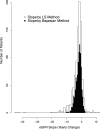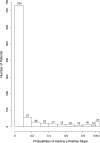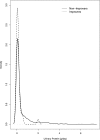Kidney function can improve in patients with hypertensive CKD
- PMID: 22402803
- PMCID: PMC3312500
- DOI: 10.1681/ASN.2011050456
Kidney function can improve in patients with hypertensive CKD
Abstract
The typical assumption is that patients with CKD will have progressive nephropathy. Methodological issues, such as measurement error and regression to the mean, have made it difficult to document whether kidney function might improve in some patients. Here, we used data from 12 years of follow-up in the African American Study of Kidney Disease and Hypertension to determine whether some patients with CKD can experience a sustained improvement in GFR. We calculated estimated GFR (eGFR) based on serum creatinine measurements during both the trial and cohort phases. We defined clearly improved patients as those with positive eGFR slopes that we could not explain by random measurement variation under Bayesian mixed-effects models. Of 949 patients with at least three follow-up eGFR measurements, 31 (3.3%) demonstrated clearly positive eGFR slopes. The mean slope among these patients was +1.06 (0.12) ml/min per 1.73 m(2) per yr, compared with -2.45 (0.07) ml/min per 1.73 m(2) per yr among the remaining patients. During the trial phase, 24 (77%) of these 31 patients also had clearly positive slopes of (125)I-iothalamate-measured GFR during the trial phase. Low levels of proteinuria at baseline and randomization to the lower BP goal (mean arterial pressure ≤92 mmHg) associated with improved eGFR. In conclusion, the extended follow-up from this study provides strong evidence that kidney function can improve in some patients with hypertensive CKD.
Figures




Comment in
-
Improvement in kidney function: a real occurrence.J Am Soc Nephrol. 2012 Apr;23(4):575-7. doi: 10.1681/ASN.2012020144. Epub 2012 Mar 8. J Am Soc Nephrol. 2012. PMID: 22402801 Free PMC article. No abstract available.
References
-
- Hunsicker LG, Adler S, Caggiula A, England BK, Greene T, Kusek JW, Rogers NL, Teschan PE: Predictors of the progression of renal disease in the Modification of Diet in Renal Disease Study. Kidney Int 51: 1908–1919, 1997 - PubMed
-
- Jafar TH, Stark PC, Schmid CH, Landa M, Maschio G, de Jong PE, de Zeeuw D, Shahinfar S, Toto R, Levey AS. AIPRD Study Group: Progression of chronic kidney disease: The role of blood pressure control, proteinuria, and angiotensin-converting enzyme inhibition: A patient-level meta-analysis. Ann Intern Med 139: 244–252, 2003 - PubMed
-
- Ruggenenti P, Perna A, Remuzzi G. Gruppo Italiano di Studi Epidemiologici in Nefrologia: ACE inhibitors to prevent end-stage renal disease: When to start and why possibly never to stop: A post hoc analysis of the REIN trial results. Ramipril Efficacy in Nephropathy. J Am Soc Nephrol 12: 2832–2837, 2001 - PubMed
-
- Hsu CY, Lin F, Vittinghoff E, Shlipak MG: Racial differences in the progression from chronic renal insufficiency to end-stage renal disease in the United States. J Am Soc Nephrol 14: 2902–2907, 2003 - PubMed
-
- McClellan W, Warnock DG, McClure L, Campbell RC, Newsome BB, Howard V, Cushman M, Howard G: Racial differences in the prevalence of chronic kidney disease among participants in the Reasons for Geographic and Racial Differences in Stroke (REGARDS) Cohort Study. J Am Soc Nephrol 17: 1710–1715, 2006 - PubMed
Publication types
MeSH terms
Substances
Grants and funding
- P20-RR11145/RR/NCRR NIH HHS/United States
- M01 RR-00080/RR/NCRR NIH HHS/United States
- P20 RR011104/RR/NCRR NIH HHS/United States
- M01 RR000052/RR/NCRR NIH HHS/United States
- 2P20RR11104/RR/NCRR NIH HHS/United States
- DK2818-02/DK/NIDDK NIH HHS/United States
- R01 DK090046-01/DK/NIDDK NIH HHS/United States
- K24 DK002818/DK/NIDDK NIH HHS/United States
- M0100032/PHS HHS/United States
- UL1 RR024989/RR/NCRR NIH HHS/United States
- R01 DK090046/DK/NIDDK NIH HHS/United States
- M01 RR00827/RR/NCRR NIH HHS/United States
- M01 RR000071/RR/NCRR NIH HHS/United States
- P20 RR011145/RR/NCRR NIH HHS/United States
- U01 DK045381/DK/NIDDK NIH HHS/United States
- 5M01 RR-00071/RR/NCRR NIH HHS/United States
- M01RR00052/RR/NCRR NIH HHS/United States
- U01 DK045386/DK/NIDDK NIH HHS/United States
- U01 DK048652/DK/NIDDK NIH HHS/United States
- M01 RR000827/RR/NCRR NIH HHS/United States
- M01 RR000080/RR/NCRR NIH HHS/United States
LinkOut - more resources
Full Text Sources
Other Literature Sources
Medical
Research Materials
Miscellaneous

